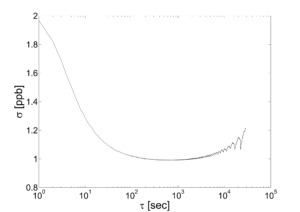Photo Acoustic Spectroscopy in gas analysis
direct NO2 measuring
PAS - Photo Acoustic Spectroscopy for gas analyzers & sensors
The Photo Acoustic Spectroscopy (PAS) is a spectroscopic method which utilizes the photoacoustic effect. This method is field proven in several applications like emissions testing of vehicles, in environmental technology (detection of air pollutants), in the medical technology and in biology.
It is a highly accurate, stable and a direct measurement (independent of background gases).
It is based on the fact that light is absorbed by gas molecules. In the photoacoustic spectroscopy the modulated light is converted into acoustic waves. The resulting soundwaves are converted into an electric signal with the use of a microphone.
Measuring principle of the PAS (NO2) sensor:

Performance of the PAS (NO2) sensor:
Allan-Variance

Linearity

The sample gas is irradiated with modulated light of a predefined wavelength. Because for many applications the particular wavelength of the examined material is in the infrared range. Therefore IR-laserdiodes are used as a lightsource. The light is electronically or mechanically modulated, for example by using a chopper.
Gas molecules absorb a part of the light, when the light frequency corresponds with an absorption band of the gas in the cell. The higher the gas concentration, the more light is absorbed.
The absorbed light causes heat and therefore a pressure rise. Due to the modulated light the pressure will alternately increase and decrease.
This generates an acoustic signal which can be detected by a microphone and then converted into an electric signal.
Technology factsheet
We have summarized the most important information about the technology, possible applications and our technical design options in a clear factsheet.
Photoacoustic sensors & gas analyzers
Benefits at a glance
Sensitivity is basically not dependent on the optical path length
Major advantage of the photoacoustic effect is the fact that sensitivity is basically not dependent on the optical path length. This allows high sensitivity from short absorption path length and highly linear concentration response over a wide dynamic measurement range from very low sample volumes.
No interfering signal and extremely accurate results
The absorption is measured directly and not in relation to the background. Therefore the PAS is one of the most sensitive methods for the detection of gases and often used in trace-gas analysis.
Low sample volume and small cell size
The small size of the PAS cells enables the measurement of very small gas volumes. In contrast to conventional methods, the sample volume can be reduced drastically.
Great price advantage
Another advantage is that the PAS is generally cheaper than other gas analysis methods. The reason for this are the microphones which are less expensive than (infrared-)detectors.
Low amount of drift
The response of the microphone is extremely stable. Therefore the drift is very low and a calibration is seldom needed.
Need help?
We look forward to help you choose the perfect gas analysis products for your needs. Talk to us about different technologies and our customer-specific photo acoustic gas analyzers & OEM sensors.
